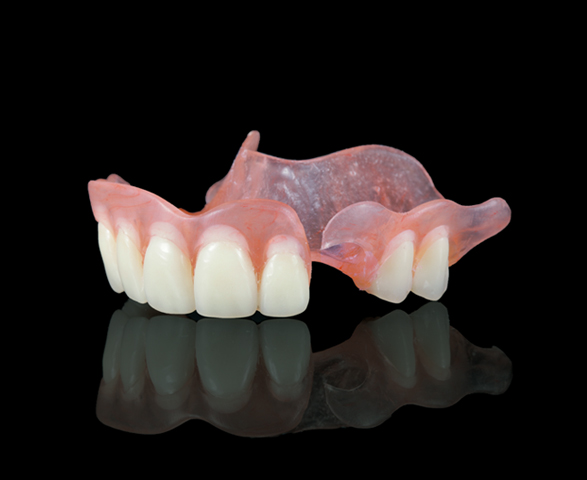Want Flexibility?
It was long thought that removable partial dentures had to be rigid to be effective. Traditionally, removable partial dentures were fabricated from a rigid metal base designed to replace missing teeth in partially edentulous patients (meaning patients that were missing only some of their natural teeth). Although full dentures and partial dentures have been used in dentistry for many decades, they can pose many problems for patients, most notably the poor aesthetics that are created from using metal to cover your natural teeth.
The innovation of the flexible partial denture in the 1950s paved the way for a new type of partial denture, which provides excellent aesthetics and comfort for patients who prefer to wear a removable denture that is affordable rather than a fixed restoration such as a dental bridge or dental implants. By using a flexible base, the restoration can adapt to the constant movement and flexibility in your mouth.
Flexible partial dentures such as those made by Valplast® are custom-fabricated in a dental laboratory. They are prescription-only products that are placed by a licensed dentist after an impression of your mouth has been taken. Most flexible partial dentures involve very simple preparation because your natural teeth don’t need to be altered in any way. Flexible partials can be virtually invisible because there are no telltale metal clasps to cover your natural teeth. Furthermore, most flexible materials blend with the tissue in your mouth so that the only thing that shows is your beautiful smile.
You’ll be glad to know that most patients become immediately accustomed to their delicate and light-weight restoration. However, you may experience a brief adjustment period, especially if you have never worn a dental appliance before. Should you experience any persistent irritation, please consult with your dentist so that he or she can make necessary adjustments to your appliance.
Why Should You Wear a Partial Denture?
It’s true that partial dentures bring the beauty back to your smile by replacing missing teeth. And that’s a big deal! But the other benefits of partial dentures are important, too.
A partial denture is used when one or more natural teeth remain in the upper or lower jaw. Flexible partial dentures are virtually invisible because there are no telltale metal clasps. In fact, the denture material blends right in with the natural color of the tissue in your mouth so no one has to know you’re wearing it.
Partial dentures also:
- Make it easier to chew and speak
- Maintain the shape of your face
- Ease the stress of your bite
- Prevent teeth from shifting
- Decrease the risk of gum disease and resulting gum disease treatment
How to Care for Your Flexible Partial Denture
Like your own natural teeth, flexible partial dentures require care and good oral hygiene. To keep your restoration looking and feeling like new, please follow these simple flexible partial denture care directions:
- Clean your appliance regularly. Most brands of flexible partials will have a specific cleaner that is recommended for regular soaking of your new denture. Please consult your dentist if you have any questions regarding the type of denture cleaner you should be using.
- Loose particles can be removed with the use of a sonic denture cleaner, or by placing the appliance under running water. Brushing a denture is generally not recommended as this may remove the polish and roughen the surface over time.
- If possible, rinse your new dental appliance after eating to remove any food particles.
- Keep the partial in water or in denture cleaner whenever it is not being worn to keep the surface hydrated.
- Remember to brush your natural teeth and gums regularly as directed by your dentist.

